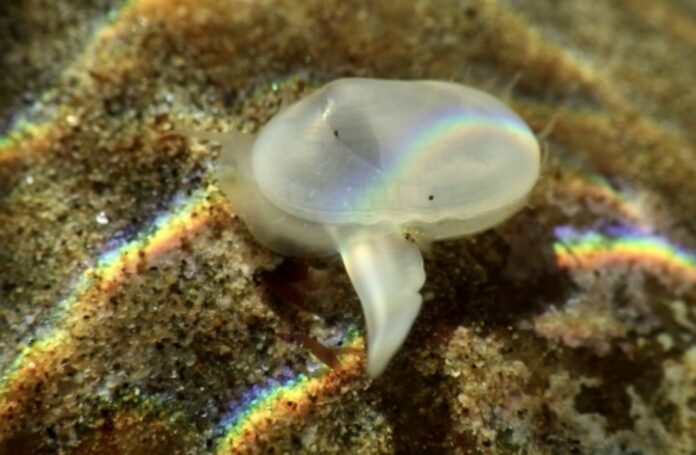It is always wonderful to discover a new species, but it is much more thrilling to rediscover a species that had been presumed extinct. A small clam that was only known from fossils until recently was found living at Naples Point, just north of UC Santa Barbara on the coast. The research was published in Zookeys.
“It’s not all that common to find alive a species first known from the fossil record,” added co-author Jeff Goddard, “especially in a region as well-studied as Southern California.”
“Ours doesn’t go back anywhere near as far as the famous Coelacanth or the deep-water mollusk Neopilina galatheae — representing an entire class of animals thought to have disappeared 400 million years ago — but it does go back to the time of all those wondrous animals captured by the La Brea Tar Pits.”
On a low tide afternoon in November 2018, Goddard was turning over rocks at Naples Point to look for nudibranch sea slugs when he saw a pair of small, clear bivalves. He said that their shells were only 10 mm long.
“But when they extended and started waving about a bright white-striped foot longer than their shell, I realized I had never seen this species before.”
Goddard was surprised by this because he has spent decades in the intertidal habitats of California, including many years at Naples Point. He stopped what he was doing right away to capture close-up pictures of the fascinating animals.
With high-quality photographs in hand, Goddard chose not to collect the rare-looking animals. He forwarded the photos to Paul Valentich-Scott, curator emeritus of malacology at the Santa Barbara Museum of Natural History, after determining their taxonomic family.
Valentich-Scott recalled, “I was surprised and intrigued. I know this family of bivalves (Galeommatidae) very well along the coast of the Americas. This was something I’d never seen before.”
He gave Goddard a few ideas but said that he would need to see the animal in person to make a proper assessment. Goddard then went back to Naples Point to get his clam. But after looking over just a few square metres for two hours, he still hadn’t found his prize. He would still miss the species many more times.
In March 2019, after nine trips, when Goddard was almost ready to give up for good, he looked under another rock and saw the needle in the haystack: There was only one species there, along with a few little white nudibranchs and a sizable chiton. Valentich-Scott would finally get his sample, and the two of them could start working on figuring out what it was.
When Valentich-Scott finally had the shell in his hands, he was even more taken aback. Although he was aware that it belonged to a genus having only one specimen in the Santa Barbara area, this shell didn’t resemble any of them. It excitedly suggested that they might have discovered a new species.
“This really started ‘the hunt’ for me,” Valentich-Scott added. “When I suspect something is a new species, I need to track back through all of the scientific literature from 1758 to the present. It can be a daunting task, but with experience, it can go pretty quickly.”
The two scientists decided to investigate an intriguing allusion to an ancient species. They were successful in locating pictures of the bivalve Bornia cooki that were published in the 1937 paper that described the species. It resembled the contemporary species. If this turns out to be true, it would mean that Goddard didn’t find a new species, but rather something like a living fossil.
It is important to note that George Willett, the scientist who discovered the species, believed he had unearthed and examined over 1 million fossil samples from the Baldwin Hills in Los Angeles. But he never managed to track down B. cooki personally. Instead, he gave it the name Edna Cook after the Baldwin Hills collector who had discovered the sole two known specimens.
Valentich-Scott asked the Natural History Museum of Los Angeles County for Willett’s original specimen, which is now known as Cymatioa cooki. The “type specimen” is what defines the species and is the final authority on the clam’s identification.
Goddard also found another piece of evidence at Naples Point. It was a single empty shell in the sand under a rock. Valentich-Scott came to the conclusion that the specimens from Naples Point and Willett’s fossil were to the same species.
“It was pretty remarkable,” he recalled.
Despite its diminutive size and secretive location, all of this raises the question of how the clam evaded detection for so long.
“There is such a long history of shell-collecting and malacology in Southern California — including folks interested in the harder-to-find micro-mollusks — that it’s hard to believe no one found even the shells of our little cutie,” Goddard added.
He thinks that currents may have brought planktonic larvae from the south during marine heatwaves in 2014, 2015, and 2016. Many marine species, including those that have been specifically identified near Naples Point, were able to expand their ranges northward as a result. This may explain why no one, including Goddard, who has studied nudibranchs at Naples Point since 2002, had observed C. cooki in the location until 2018. This depends on the animal’s development rate and lifespan.
“The Pacific coast of Baja California has broad intertidal boulder fields that stretch literally for miles,” Goddard noted, “and I suspect that down there Cymatioa cooki is probably living in close association with animals burrowing beneath those boulders.”
Image Credit: JEFF GODDARD
